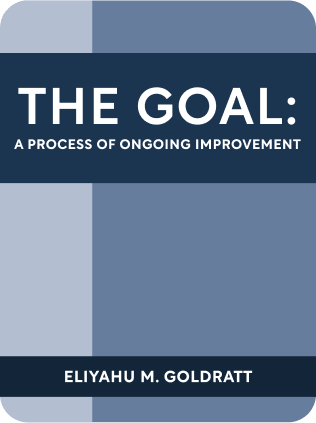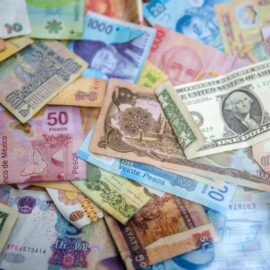

This article is an excerpt from the Shortform book guide to "The Goal: A Process of Ongoing Improvement" by Eliyahu M. Goldratt. Shortform has the world's best summaries and analyses of books you should be reading.
Like this article? Sign up for a free trial here .
What is The Goal book about? How does The Goal: A Process of Ongoing Improvement help you increase production and profitability?
The Goal book reminds you that the main objective for any business is to make money. It provides guidance for how to address production issues and increase profitability.
Keep reading for the key points from The Goal book.
Shortform Introduction to The Goal Book
The Goal: A Process of Ongoing Improvement is a classic management text, and on Jeff Bezos’s short-list of books recommended to new managers.
The Goal is written in the form of an allegory, where a manufacturing plant manager has to reduce a large backlog of orders and improve factory throughput. Its management lessons are interwoven with the manager’s epiphanies. Because we felt the lessons were more important than the narrative, we’ve focused on the teachings and theory, and we’ve summarized the narrative in a chapter at the end.
What can you apply the lessons in this book to? It’s an easy leap to apply The Goal: A Process of Ongoing Improvement to manufacturing, operations, supply chain, and automation problems.
It takes a bit more thinking to apply it to knowledge work, larger projects, or your personal life, but the principles are generalizable. To really get the most out of this The Goal book summary, think constantly about how you can apply it to your own situation – whether that’s closing sales clients, creating software products, managing a team, or writing books.
Take the advice of Ray Dalio in Principles: view yourself top-down as a machine, digesting inputs and creating outputs. From this perspective, you’ll be capable of studying and optimizing yourself.
The Goal Book Overview
Productivity is defined as bringing you closer to your goal. Every action that brings you closer to your goal is productive. Every action that does not bring you closer is not productive, even if it seems so.
The Goal of every business is to make money. Likewise, activities that do not bring you closer to making money are not productive.
- Beware of defining subgoals that do not really drive toward the Goal, like production efficiency, team size, money raised, etc.
Organizations can be measured by 3 metrics: Throughput, Inventory, and Operational Expense.
- Throughput: the rate at which the system generates money through sales
- Inventory: all the money system has invested in purchasing things it intends to sell
- Operational expense: all the money the system spends to turn inventory into throughput
Ideally, your activities improve all three at once.
- Many companies focus primarily on decreasing operating expense, which can lead to unproductive behaviors that stifle throughput. Instead, switch your mindset to increasing throughput.
Bottlenecks and What They Mean
The bottleneck of the system determines the throughput of the entire system. Bottlenecks are an important focal point in The Goal book.
- By definition, the throughput of the system cannot be greater than the capacity of the bottleneck. Where is the weakest link in the chain?
- This means the value of an hour lost at the bottleneck is equal to the value of the entire system.
- Even if a bottleneck costs $5/hour to run, if the factory is producing $1000 of goods per hour, then an hour of the bottleneck idling is costing $1000/hour.
- Constraints can be equipment, people, or policies.
Increase capacity at the bottleneck through a variety of interventions.
- Prevent idling by running the bottleneck all the time, ensuring inventory upstream of the bottleneck, and preventing back-ups at the bottleneck.
- Bypass parts past the bottleneck if it’s not strictly necessary.
- Improve quality of upstream work to prevent bottleneck working on poor-quality work.
- Add new producers (eg machines, people) at the bottleneck, even if they’re less efficient.
- Outsource bottleneck capacity to outside the organization.
- (If you’re a bottleneck as a human manager or a worker, and not a factory step, consider implementing analogues of each of the above)
The non-bottlenecks should be synchronized with the bottleneck, which means idling at non-bottlenecks is acceptable. If both the bottleneck and non-bottleneck go full steam ahead, the non-bottleneck will produce surplus inventory, which adds cost and causes traffic jams.
To coordinate this, use Drum-Buffer-Rope recommended in The Goal book.
- Drum: pace non-bottlenecks production rates with bottleneck rates
- Buffer: provide enough buffer inventory upstream of bottleneck to prevent idling
- Rope: allow up to a threshold max surplus inventory, after which the non-bottleneck is idled

———End of Preview———
Like what you just read? Read the rest of the world's best book summary and analysis of Eliyahu M. Goldratt's "The Goal: A Process of Ongoing Improvement" at Shortform .
Here's what you'll find in our full The Goal: A Process of Ongoing Improvement summary :
- How to increase your personal output
- How to increase your team's output
- Why obsessing over cost efficiency isn't going to help you with production






